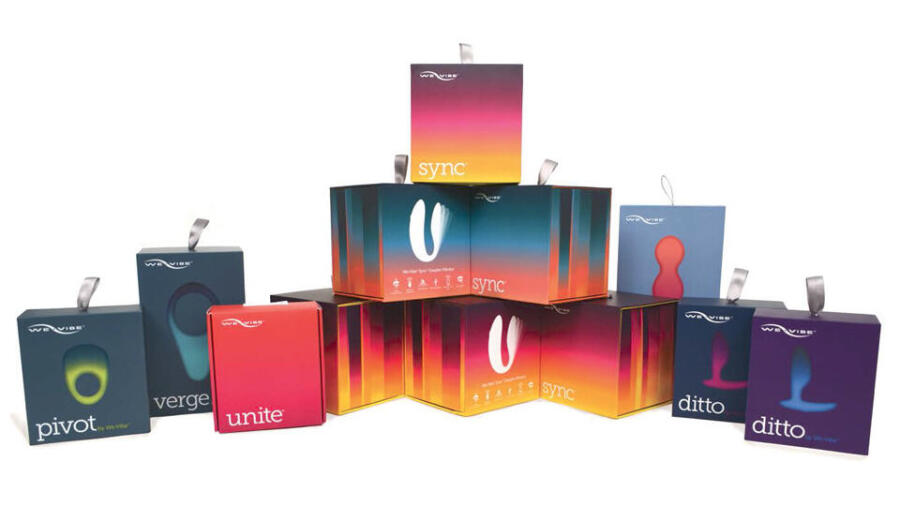Before consumers make the decision to purchase a pleasure product, they see the packaging — perhaps in person in a brick-and-mortar store, or perhaps online as a digital image. The more attractive the packaging, the more likely consumers are to go ahead and make a purchase. And in 2017, manufacturers are putting considerable time and effort into their packaging whether they’re selling vibrators, butt plugs, nipple clamps or introductory bondage kits.
Conde Aumann, account executive for The Screaming O, stressed that as competitive as the pleasure products sector is in 2017, manufacturers can’t afford to have packaging that isn’t first-rate.
Strong packaging design has the power to inspire a sale and make it feel like a special treat, even if the product inside the box is a simple single-speed vibe. -Conde Aumann, The Screaming O
“Packaging is a shopper’s first impression,” Aumann told XBIZ. “It’s the first thing they see on a shelf or wall, and if the color palette, tagline or general design speaks to them, they’ll reach for that product first — often before they even know what product lies inside. Strong packaging design has the power to inspire a sale and make it feel like a special treat, even if the product inside the box is a simple single-speed vibe.”
Aumann continued, “Because sex toys can be so personal, it’s essential that the packaging exudes the same feeling that we want the user to experience once they rip open the box. It’s like opening a gift; half the fun is opening the wrapping in anticipation of the pleasure inside.”
Andy Green, president of XGen Products, asserted that consumers of pleasure products have grown increasingly savvy — and with savvier customers comes a need for more informative packaging.
“All of our packaging has more info on it,” Green told XBIZ. “Customers have gotten more knowledgeable over the years and also, more technical. We also have four languages on most of our electronic items, Bodywand and Secrets: French, English, German, Spanish. This really helps us worldwide and also, in some parts of our country. All of our Bodywands are tested thoroughly. We also (use) all of the lab logos that have approved our items for safety. None of our packaging is explicit; it can be merchandised anywhere in the store — or even in different types of stores, for that matter.”
In recent years, sex toys have been enjoying more mainstream exposure than they did in the past. Stephanie Keating, brand manager for We-Vibe, noted that the desire to reach mainstream outlets is influencing the type of packaging manufacturers use.
“As our industry matures, product packaging is certainly becoming more similar to mainstream consumer packaged goods,” Keating told XBIZ. “Packaging is so much more than a container with product messaging; it’s part of the full customer experience with the brand. It communicates with how it feels in the customer’s hand, with how it relates to what’s inside and with the experience of unboxing. Consumers connect with premium product packaging on an emotional level.”
Keating continued, “Our packaging is designed to connect with consumers on that emotional level and for them to immediately know that We-Vibe products are premium quality. We’ve researched the information that consumers value on our products, and we’ve designed simple icons to communicate the key features that customers care about. Body safety, warranty and customer care information are essential; they speak to the quality of the product and let customers know that we stand behind it.”
Joanne Queenin, executive administrator for Sportsheets International, emphasized that even with BDSM products, packaging need not be overly explicit. According to Queenin, packaging can appeal to BDSM consumers without intimidating mainstream outlets.
“Your packaging needs to ride a fine line in today’s market,” Queenin told XBIZ. “Appeal to the meat-and-potatoes consumer that is into BDSM and fantasy play, but also, draw in that new consumer — the couple that hasn’t experimented yet, or has dabbled but are unsure of what they are doing. Those are the people you want to attract. If the packaging is scary and offputting or too over the edge, they’ll pass it right by in the stores. If you’re lucky, they will talk to a retail clerk.”
Queenin added, “Online is a whole different story. You never get the opportunity to ‘sell’ your products; the art has to do it all for you.”
Rob Phaneuf, vice president of product development for Pipedream Products, explained that packaging is a crucial part of branding in the sex toys/pleasure products market.
“At Pipedream Products, we have been creating products for 40-plus years in the adult category,” Phaneuf told XBIZ. “With this, we have seen a big change in the packaging design. While the company has always been committed to offering quality products at a good price, when you look at the evolution of our products, they just keep getting better year after year. And the packaging also reflects this. For us, packaging is huge when we create a new line. The top-selling King Cocks, Pipedream Extreme and Fetish Fantasy lines have been big successes, and this is a testament to the power of packaging and branding. Our Planogrammer also gives us the ability to create custom, in-store displays no matter how big or how small the space. This visual appeal really drives sales and helps our products stick out amongst the crowd to consumers.”
Patrick Lyons, vice president of marketing for Diamond Products, noted that with all the companies in the Diamond family — Pipedream Products, Jimmyjane and Sir Richard’s — packaging reflects the mainstreaming of pleasure products.
“Packaging for pleasure products, especially in the premium sector, now looks like any other product you would find in the electronic goods or body care industry,” Lyons told XBIZ. “It speaks to features and technical aspects and is presented in a modern format. I think the product packaging and presentation being more mainstream has helped the industry cross over into mainstream as well.”
Lyons added, “The packaging needs to communicate that the product is quality and has all of the features the consumer is looking for. Instead of speaking to males or females exclusively, we like to speak to how you can use these products with your partner. We find a lot of our customers are using our products as a shared experience, and we want to promote how the products can be used to enhance (a) connection between two people.”








